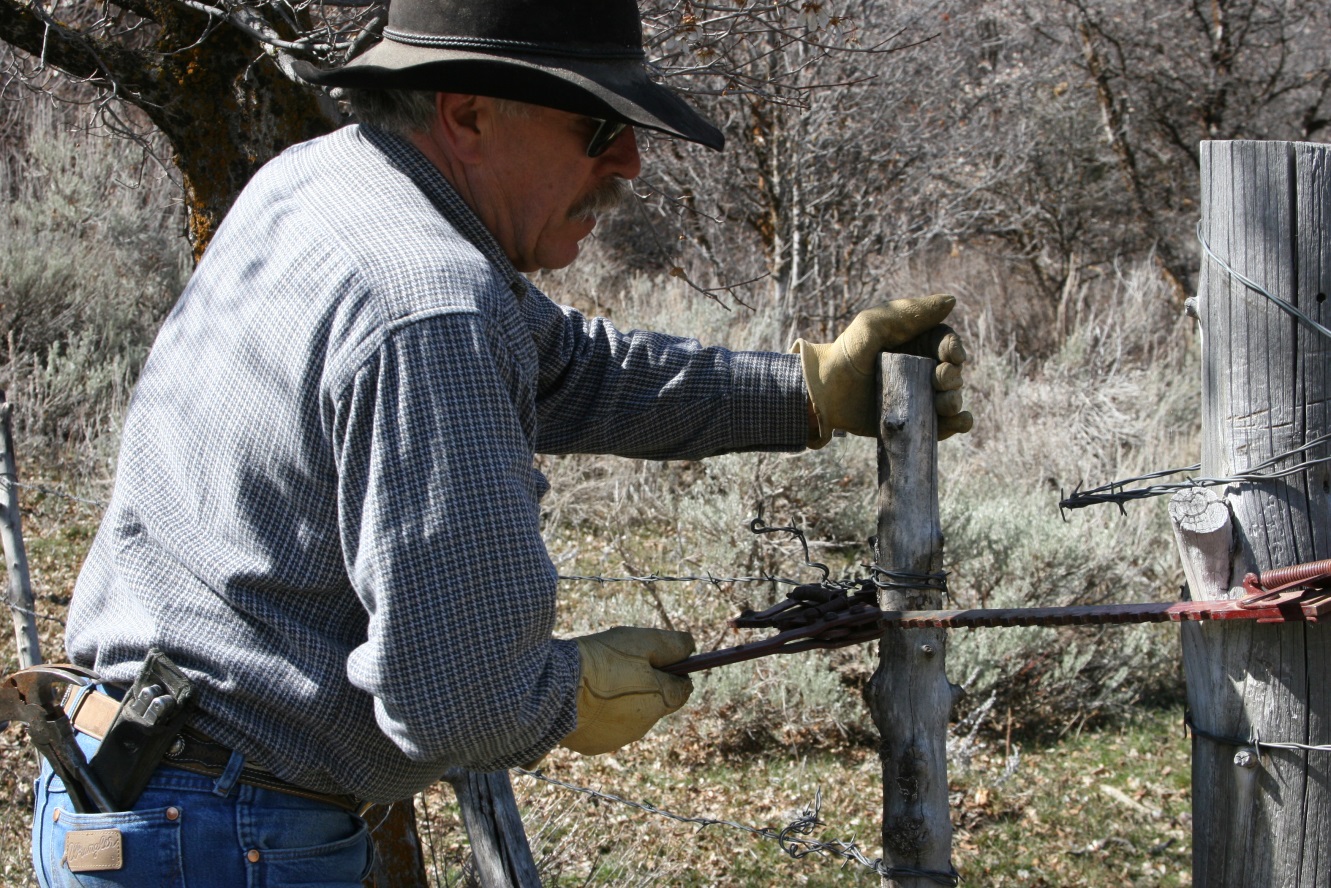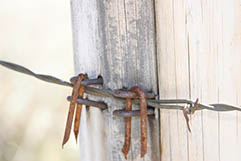…And A Handshake Agreement
Each season, Rancher Jay Wilde walks the country side putting up, taking down and repairing twenty miles of fencing on the Diamondback W Ranch in Mink Creek, Idaho, the summer range for his cow-calf operation.
In 1995 after having been gone for twenty years, Jay returned home to Mink Creek to take over the ownership of his childhood farm and adjoining ranch lands. The first thing he did was to erect a mile of fencing on a hill on the north side of the range. It is a type of fencing called “lay-down” fencing, designed to be laid down every fall in preparation for the winter snows that can destroy most other types of fencing, especially on a hill.
Today is one of the first real warm days of spring, (it tops out at about 60°)—the first opportunity to get some of the work done on the twenty miles of fencing that will need attention throughout the upcoming summer season. If Jay can get a head start, then so much the better for the work that will be generated when he comes back in several weeks with the 160 cow-calf herd.
The fence to be worked today is accessed by a Honda 4-wheeler. The terrain is steep in some areas, and the line of fencing goes steadily uphill a half mile east and a half mile west, almost to the 6,000 foot level. The ground is still spongy in spots, and in a little draw, under the shade of a stand of Maples to the east, snow still covers the ground.

Jay’s shirt pockets are filled with the extra staples he needs to replace on the posts; his back pocket holds the combination hammer-twister-cutter-puller tool called a “plammer” and a small roll of unbarbed, twistable wire.
Today’s section is where Jay and a neighbor share a boundary. He explains the philosophy used to decide who maintains what stretch of fencing when it’s a shared boundary. You and your neighbor stand on your own ground on opposite sides of the fence and shake hands over the wire. Whatever stretch is to your left—that is the stretch you agree to maintain. You try to stand in a spot that is about the middle of the line but sometimes you just decide from what point you can most conveniently work, even if it’s not actually equal footage.
Metal posts are lying down everywhere. It looks like a big wind came and scattered them, but that’s the way they were put last fall. Jay explains the methods he uses to put up the 3-wire lay-down fencing; and to make simple repairs. The first post is picked up and set in place, attached to the permanent brace; usually built from heavy wooden posts. There is one permanent brace every 1/8th miles, and the posts in between are free standing, called stays or dancers. About every third post is attached to a “T” post. The tension on the three lines of barbed wire attached to the posts is what keeps them up and in place. The stay or dancer is set in place next to its permanent member with a wire loop, and the wires are tightened with a wire stretcher.

Once the stays or dancers are back in place, and the wires tightened, the wires are secured onto the posts by metal looped staples that have been pounded into the post, and anchored with another staple from Jay’s pocket.
 Maple or Aspen posts are harvested from the forest to build the fence. Some are a little green, so they work well for pounding the first staples in. Later the wood gets too hard to hold a staple, and you have to pound some new ones in where some have fallen out, or use a wire twist to hold the barbed wire in place.
Maple or Aspen posts are harvested from the forest to build the fence. Some are a little green, so they work well for pounding the first staples in. Later the wood gets too hard to hold a staple, and you have to pound some new ones in where some have fallen out, or use a wire twist to hold the barbed wire in place.
Further on up the hill, where the elevation takes a jump, there is a sort of three post brace to give the first post on the higher ground more stability. This is on a rock ledge and digging a post hole or pounding in a steel post is impossible. There are some older posts on up there—some put there as early as one hundred years ago, when this country was first used for ranching. You can recognize the older posts—they’re bigger and usually made of cedar or juniper and have lots of character!

This can be an easy relaxing kind of work, once the initial effort of setting permanent posts is done. You can stop and rest for a minute if you get winded following the fence line up the hill. Looking out over the expanse of the mountainside, you can decide what work you’d like to tackle this season—maybe clear that hill of sage brush or Maple over there on the south side, then plant with grass. Or you can just muse on the beauty of this spot, let your mind sort of wander around for a bit with no particular agenda at all. Jay remembers childhood experiences working and playing on the ranch. That’s the appeal of the work of ranching, and this whole western lifestyle—there are times when you work alone, and you’ve got moments like this to reflect, out in nature.
It takes a few hours to do this half mile of fencing going east. Looking back to the west, it’s a little steeper there. That stretch of fencing will have to wait until another day, when the weather dries the spongy ground a bit more, and a neighbor is around to honor the handshake agreement.
Story and photos by Lisa Duskin-Goede, a folklorist working in the Intermountain West and coordinating the fieldwork and research of the Bear River Heritage Area. For more information call 435-713-1426.

